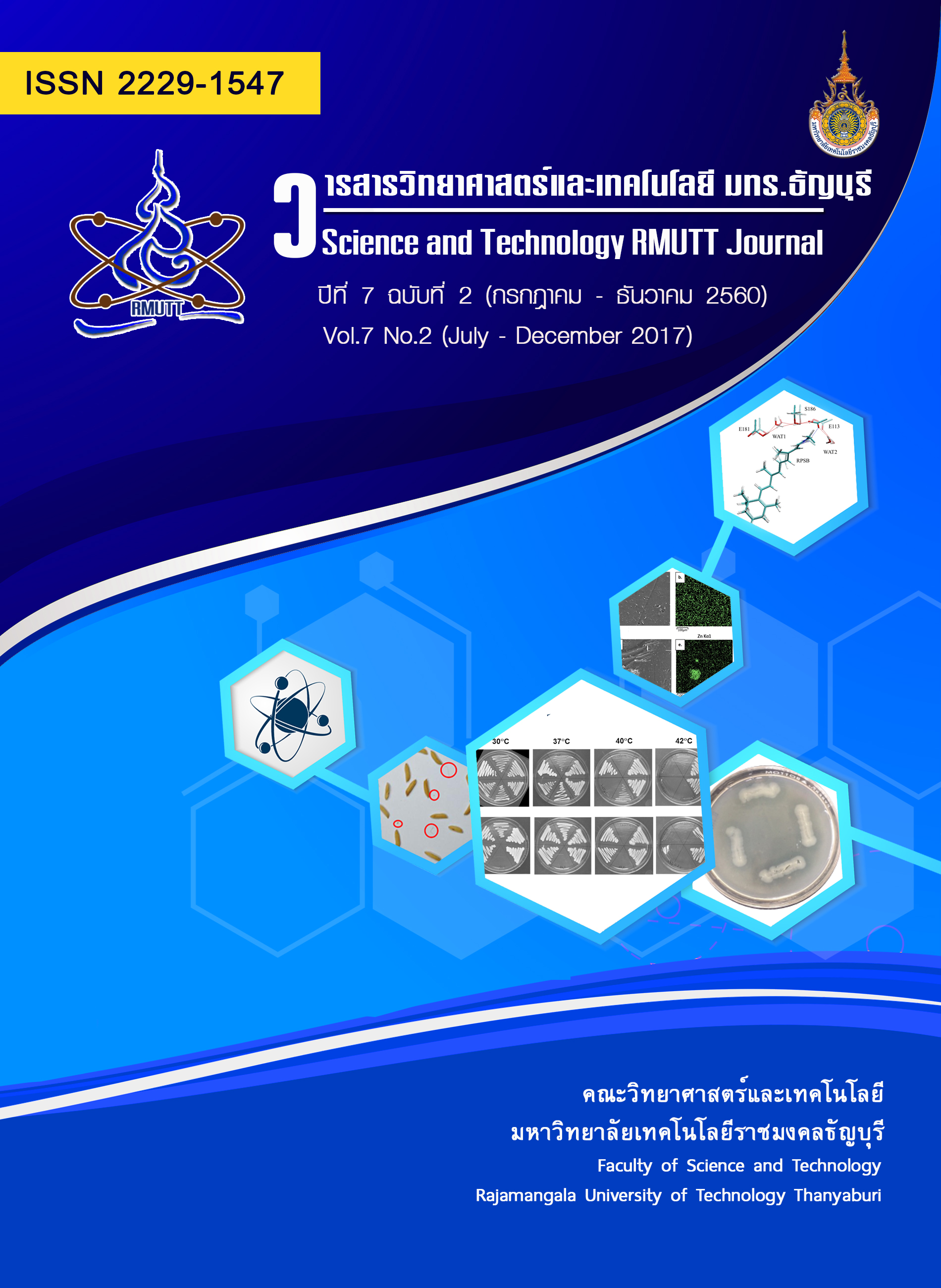Development of native Thai rice drink products using probiotic bacteria Lactobacillus plantarum
Main Article Content
Abstract
The purposes of this research were to evaluate the properties of probiotic strain L. plantarum TISTR 951 and the application of this strain for rice drink products. The capability of bacteria for carbohydrate utilization of Thai rice grains was then evaluated, the results showed that L. plantarum TISTR 951 had an ability to hydrolyze carbohydrates in 11 cultivars of rice grains i.e. Kao-Argad, Taptim-Chumpae, Kao-Jek, Hom-Baitoey, Lueng-Patiw, E-Tia, Lepnok, Tahaeng, Sangyod, Phrae Dann and U-Bon. The test of antibacterial activity using an agar well diffusion method revealed that L. plantarum TISTR 951 could inhibit the growth of all pathogens including Aeromonas hydrophila, Bacillus cereus, Escherichia coli, Proteus vulgaris, Pseudomonas aeruginosa, Salmonella typhimurium, Serratia marcescens, Staphylococcus aureus, Vibrio cholerae and Vibrio parahaemolyticus. In probiotic-supplemented rice production using Lueng Patiw cultivars as carrier for probiotic bacteria, L. plantarum TISTR 951 could grow well in all beverage products. The highest survival rates (93.51%) was found in rice milk, followed by rice bubble drink (90.98%) and agar-rice bubble drinks (83.92%). Whereas in products using Phrae Dang cultivar, the highest survival rates (98.99%) was found in agar-rice bubble drinks, followed by rice bubble drink (92.75%) and rice milk (91.63%). For microbiological safety test in probiotic products, E. coli was not found in all products, whereas the aerobic bacteria were about 103 CFU/mL and molds were about 104 CFU/mL after storage at 4ᵒC for 1 month. According to the data, this study can be further improved, developed and applied to new probiotic products for healthy food industries.
Article Details
References
วินัย แก้วมุณีวงศ์. โปรไบโอติคจุลินทรีย์ทางเลือกเพื่อสุขภาพ. สำนักงานพระพุทธศาสนาแห่งชาติ, กรุงเทพฯ. 2556.
Dunne C., O’Mahony L., Murphy L., Thornton G., Morrissey D., O’Halloran S., Feeney M., Flynn S., Fitzgerald G., Daly C., Kiely B., O’Sullivan G.C., Shanahan F. and Collins J.K. In vitro selection criteria for probiotic bacteria of human origin: correlation with in vivo findings. Am. J. Clin. Nutr. 2001. 73: 386S-392S.
Saarela M., Virkajärvi, I., Nohynek, L., Vaari, A. and Mättö, J. Fibres as carriers for Lactobacillus rhamnosus during freeze-drying and storage in apple juice and chocolate-coated breakfast cereals. Int. J. Food Microbiol. 2006.112: 171-178.
อรอนงค์ นัยวิกุล. ข้าว: วิทยาศาสตร์และเทคโนโลยี. สำนักพิมพ์มหาวิทยาลัย เกษตรศาสตร์, กรุงเทพฯ. 2560
Ratithammatorn T., Thongwai N., Yotsawimonwat S., Sirithunyalug B. and Sirithunyalug J. Adhesion and utilization of native starch granules by Lactobacillus amylovorus. Chiang Mai Univ. J. Nat. Sci. 2012. 11: 29-42.
Tulumoglu S., Yuksekdag Z., Beyatli Y., Simsek O., Cinar B. and Esra Y. Probiotic properties of lactobacilli species isolated from children’s feces. Anaerobe. 2013. 24: 36-42.
Forbes B.A., Sahm D.F. and Weissfeld, A.S. Bailey & Scott’s Diagnostic Microbiology.11th Ed. Mosby Inc., St. Louis. 2002.
Bao Y., Zhang Y., Zhang Y., Liu Y., Wanga A., Dong, X., Wang Y. and Zhang H. Screening of potential probiotic properties of Lactobacillus fermentum isolated from traditional dairy products. Food Control. 2010; 21: 695-701.
สมคิด ดีจริง และอรุณี คงดี. การแยกและคัดเลือกจุลินทรีย์ที่ผลิตกรดแลคติคจากแป้งโดยตรงเพื่อลดต้นทุนการผลิตพลาสติกชีวภาพ. มหาวิทยาลัยแม่โจ้. 2556.
Thomsen M.H., Guyot, J.P. and Kiel, P. Batch fermentations on synthetic mixed sugar and starch medium with amylolytic lactic acid bacteria. Appl. Microbiol. Biotechnol. 2007. 74: 540-546.
สำนักพัฒนาผลิตภัณฑ์ข้าว กรมการข้าว. เอกลักษณ์ข้าวเหลืองปะทิว. แคมป์สนุกคิดกับอินทัช. แหล่งที่มา: http://www.intouchstation.com/view.php, 27 ธันวาคม 2559.
Chukeatirote, E. Potential use of probiotics. Songklanakarin J. Sci. Technol. 2003. 25(2): 275-282.
Duangjitcharoen Y., Kantachote D., Ongsakul M., Poosaran N. and Chaiyasut C. Selection of probiotic lactic acid bacteria isolated from fermented plant beverages. Pakistan J. Biol. 2008. 11: 652-655.
ส่งศรี มหาสวัสดิ์, วรณัฏฐ์ อนันตศิลป์, นนทวิทย์ อารีย์ชน และ ลัดดาวัลย์ รัศมิฑัต. ผลของ Lactobacillus ต่อการยับยั้งการเจริญของเชื้อ Vibrio spp. และความต้านทานโรคของกุ้งกุลาดำวัยอ่อน, รายงานสืบเนื่องจากการประชุมทางวิชาการของมหาวิทยาลัยเกษตรศาสตร์ ครั้งที่ 41 (สาขาประมง). กรุงเทพฯ, ประเทศไทย. 3-7 กุมภาพันธ์ 2546. 336-343.
สริสา สุมงคล. การเพิ่มการรอดชีวิตของแบคทีเรียโปรไบโอติกโดยใช้วิธีการห่อหุ้มร่วมกับเส้นใยจากพืชหัว. วิทยานิพนธ์ ปริญญาโท. มหาวิทยาลัยสงขลานครินทร์. 2556.
จุฬาลักษณ์ ชูพรหม. การห่อหุ้มเซลล์โปรไบโอติคร่วมกับพรีไบโอติคและศึกษาการรอดชีวิตในสภาวะที่เป็นกรดและเกลือน้ำดีในหลอดทดลอง. วิทยานิพนธ์ปริญญาโท. มหาวิทยาลัยสงขลานครินทร์. 2553.
Finney P.L. Potential for the use of germinated wheat and soybeans to enhance human nutrition. Advances in Experimental Medicine and Biology, 105 Nutr. Improv. Food Feed Proteinsm. 1978. 681- 701.
Liang J., Han B.Z., Nout M.J.R. and Hamer R.J. Effects of soaking, germination and fermentation on phytic acid, total and in vitro soluble zinc in brown rice. Food Chem. 2008. 110: 821-828.
สถาบันวิจัยวิทยาศาสตร์สาธารณสุข กรมวิทยาศาสตร์การแพทย์ กระทรวงสาธารณสุข. Escherichia coli. แหล่งที่มา: http://nih.dmsc.moph.go.th/data/data/fact_sheet. 25 ธันวาคม 2559.


